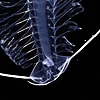HOME | DD
 KingDilophosaurus — Blacktip arrowjaw
KingDilophosaurus — Blacktip arrowjaw

#creature #creaturedesign #fish #marine #species #worldbuilding #xenobiology #creatureconcept #speculativebiology #specevo #worldbuildingart #worldbuildingspecies #alien #aliencreature #speculativeevolution #speculativezoology
Published: 2024-04-13 13:29:30 +0000 UTC; Views: 3907; Favourites: 99; Downloads: 5
Redirect to original
Description
Hey, sorry for the long wait. This was posted on Instagram ages ago, but I didn't have much motivation to create a suitable description for this one after my progress on it wiped. Twice. Kinda sucks, eh? Well, I got to doing it now.The focus will shift from the coasts to the deep sea soon, so be prepared to see some really weird creatures.
---
A bright, sunny day in Alladoras's tropics. A school of collared chovy, herring-like schooling pelagys common in the southern hemisphere, travel through the radiant carpgrass plains. They move quickly, with their flanks rippling with perfectly synchronised movement. They seek to school simply for protection in the numbers, each individual following their neighbours movements in order to move in sync, creating a tight school, in which they appear as something much larger, hopefully dissuading predators. But, not all predators are fooled by the trick. A flashing arrow strikes into the centre of the school, causing them to split apart. That arrow was not actually an arrow, but a predatory pelagys.
The species? A blacktip arrowjaw, who has caught its prey, speared on the end of its harpoon like beak.
The blacktip arrowjaw (Hastagnathus dolichus) is a hastagnathid, distantly related to the grapsharks and aeuna, as identifiable by their distinctive apidose fins (both ventral and dorsal), which helps to determine its speed when swimming due to the large amount of nerve endings in them. Unlike its pelagic relatives, the arrowjaws are relatively small (the largest only reaches about a metre, and the blacktip only reaches 56 centimetres maximum length), but possess massive, elongated rostrums (which appear to be similar to ancestral grapshark raptorial mandibles, and appear to be ancestral) with massive, needle-like teeth lining the sides. The teeth at the direct front of the jaw jut outwards, giving the mandibles a sharpened tip. The teeth on the jaws interlock, designed to catch slippery little pelagys, with their elongated rostrums giving them extra reach, allowing them to catch prey from within a school. However, their other method of hunting prey is more unique, and a lot more fatal.
Arrowjaw mandibles are notably extremely resistant to stress and can withstand a lot of concussive force. The external layer is made out of a dentine-like component, which is very resistant to damage. Even the bones are strong, and despite their size, are not easy to break. This may seem like a strange adaptation, but its perfect for their method of hunting. In order to hunt, they typically swim directly at a school of pelagys, as fast as possible (they might jump above the water, into their prey directly from above, using a phenomenon called Snell's Window, in which from an underwater viewer, the surface of the water may appear as a 'window' of light, with the edges being darker and distorted to hunt their prey), directly spearing their prey in a vital area through their spear-like jaws. Sometimes, they go straight through the flesh of their prey, or break off a piece of their prey. Most of the time, their aim is near perfect, but occasionally they might spear the wrong area, like the tail. After they've captured their prey, they pull themselves out and start devouring. Usually, they feed on prey smaller than their cephalons, but if their prey is large, they have to break off little pieces of flesh in order to eat. Sometimes, they aim improperly and may impact the substrate or rocks, which knocks them out temporarily. An arrowjaw's unique method of hunting prey may seem quite unusual and even pretty dangerous, but it allows it to kill prey much larger than it, making them one of the most unexpectedly deadly predators of Alladoras.
Aside from their extreme deadly nature, arrowjaws are also hunted as prey themselves; by crescentjack, aeuna and grapsharks. Their smaller size makes them perfect quarry, which makes them at a place between prey and predators larger than themselves, as mesopredators in the grand foodweb of the Alladorian seas. In order to protect themselves from predators, they group together in small shoals of 10 individuals, often seen swimming under the surface of the water, with some having shiny skin (specifically the Dolichodontinae subfamily) in order to dissuade predators, with guanine crystals located in the skin, which grant it reflective properties. The young of all arrowjaws, such as the blacktip have shiny skin, but in the blacktip and some other species, they eventually lose the guanine crystals in their skin, for reasons unknown. Despite their status as mesopredators, these unique predators also are capable of giving some larger creatures some serious injuries; a grapshark is known to have an arrowjaw mandible still stuck in its eye socket, which appears to be a miscalculated aim, with the arrowjaw unable to slow itself down before hitting the grapshark straight in the eye at such high speeds its jaw actually broke. Gallantees have been seen with scars and holes in their fins from arrowjaw impact, and some pelagys still survive a strike, with a slurpfish having the beak of an arrowjaw straight through its tail, which killed all movement in that area, but it still survived. Their status as predators must not be forgotten, however, even as they are small and often hunted by other species, they are still extremely successful predators.


















